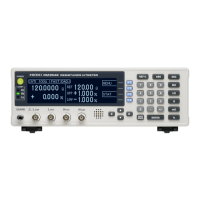Appendix 3 Unstable Measurement Values
A3
Appendix
If the measurement value is unstable, verify the following.
(1) Effect of Noise from Power Supply Lines
Noise from power supply lines arises from commercial power, and not only from power lines or outlets, but
also as radiated emissions from fluorescent lights and home appliances. The frequency of the noise from
power supply lines depends on the commercial supplied power frequency, and is typically 50 or 60Hz.
To minimize the affects of this noise from power supply lines, measurements are generally timed to occur at
an integer multiple of the supplied power period.
The instrument provides FAST, MEDIUM, and SLOW
measurement speed settings.
With the FAST setting, measurements are not syn-
chronized with the power line period, so high resis-
tance or low-power resistance measurements may
be scattered.
In such cases, use the SLOW setting or take noise
suppression countermeasures.
For high-resistance measurements, connecting the
shield to the GUARD potential is helpful.
For the lower resistance ranges and for low-power
measurements, the measurement wires should be
twisted together, apart from the GUARD-potential
shield.
Even when the integration time is set by a PLC, mea-
sured values are unstable if the line frequency setting
is 60 Hz and the instrument is used in a 50-Hz region.
Confirm the line frequency setting of the instrument.
(2) Using Low-Power Resistance Measurement
Low-power resistance measurement employs a smaller measurement current than normal measurements.
Therefore, measurements are more susceptible to the effects of external electrical noise and thermal emf.
Measurement should be conducted as far as possible from devices emitting electric or magnetic fields such
as power cords, fluorescent lights, solenoid valves and PC displays. If electrical noise ingress is a problem,
prepare the measurement leads as shown in Figs. 2 and 3.
If thermal emf is a problem, use the RM3542’s OVC function. If OVC cannot be used for reasons such as tact
time limitations, use a low-thermal emf material such as copper for wiring, and protect against airflow on con-
necting parts (test object or connectors).
Appendix 3 Unstable Measurement Values
Noise from Power Supply Lines
Combined with Measurement Signal
Ideal Measurement Signal (DC)
Integration Period
Figure 1. Effect of Noise from Power Supply Lines
Figure 3. For Low-Power Resistance Measurements
Figure 2. For High-Resistance Measurements
Metal Cover
Metal Cover
Twisted

